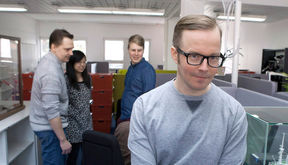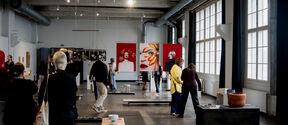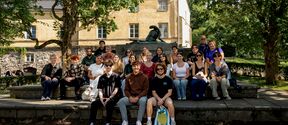Researching Ice

Ice Mechanics Assistant Professor Arttu Polojärvi is brimming with satisfaction. The renovation and upgrading of the model basin used for Aalto University’s ice and marine technology research is now complete.
- We can now continue our model tests in the ice basin. As part of the renovations, part of the basin has been equipped with an adjustable floor, so we can now study the interaction between ice and built structures in shallow waters as well.
The ice tank, measuring at 40m by 40m, is the only one of its kind in the world. Usually such test basins are longer than they are wide.
- In Aalto’s basin it is possible to model the behaviour of broad ice fields and wide structures. Also, manoeuvring tests can be carried out with model ships, such as turning a ship in ice or open water, Professor Polojärvi explains.
The ice tank has facilitated research at Aalto University for around 25 years.
Sea ice fails
For a long time, Finns have been interested in ice, ice navigation, and the ice loads exerted on Arctic marine structures and ice-going vessels. The reason is obvious: most exports and imports are transported by ship over the Baltic Sea, which freezes over for part of the year. Logistically, Finland is like an island. In addition, Finland is part of the Arctic region and internationally high quality arctic technology research is carried out in the country in order to support sustainable development.
Arttu Polojärvi and his colleagues study the behaviour of sea ice and the effect of ice fields on marine structures, such as lighthouses, offshore platforms and wind power stations. They are interested in understanding what kinds of loads the moving ice masses exert on structures and boats and, in particular, how these loads are generated and how the details of sea ice behavior are related to the loads.
The research findings can be applied in the construction of safe and efficient marine structures as well as ships with optimal features for operating in icy waters.
- We do not yet understand very well all that happens in sea ice when an ice field collides with a built structure. The research is challenging because the ice breaks up into different-sized pieces which then interact with each other, with the unbroken ice field, and with the structure.
Research is carried out more and more using computational modelling techniques. For this purpose, the researchers have for a number of years been improving their computational models for the sea ice and its failure. Increases in the computing power mean that even more complex modelling can be carried out.
‘The modelling also produces the kind of information which, due to difficulties in performing measurements, is hard to obtain from the model tests carried out either in natural conditions or in the ice tank. All methods, however, are used in conjunction with each other, not least because the computational models need to be continually tested and validated.
Theory and practice
Pofessor Polojärvi will be teaching ice mechanics in the new Master’s Programme in Mechanical Engineering, due to begin in Autumn 2016, as part of the courses belonging to the Arctic technology study path.
- The field is interesting and the Aalto studies related to the topic are diverse. Students get to use applied mechanics skills and models and also participate in experiments both on the model scale and at sea, Polojärvi explains.
The master’s programme provides students interested in cold climate engineering with different kinds of training paths. Students also have the opportunity to apply for the new Nordic Master’s in Cold Climate Engineering.
- Partnering with us are the Technical University of Denmark (DTU, Denmarks Tekniske Universitet) and the Norwegian University of Science and Technology (NTNU, Norges teknisk-naturvitenskapelige universitet). We hope that the joint master’s programme will increase student exchange between Nordic countries.
In Professor Polojärvi’s opinion, employment prospects in the sector are good as more and more expertise on cold regions and Artic is needed as, for example, ship traffic in northern sea areas is increasing. This is partly due to the climate warming.
Graduates from master’s programmes find work in a variety areas, including universities and research institutions, shipyards, companies developing Arctic technology or engaged in offshore operations, classification societies and authorities responsible for sea traffic.
Contact information:
Assistant Professor Arttu Polojärvi
arttu.polojarvi@aalto.fi
Read more news
Growing Materials, Growing Ideas: Inside the Biomaker Studio
At Aalto University’s Biomaker Studio, initiated by Ena Naito, students and researchers experiment with living materials, from algae to mycelium, creating an open, interdisciplinary space where design, biology, and collaboration grow together.
The year in Review: What happened in 2025?
A recap of the milestones of the Master in Contemporary Design in 2025
“This hands-on approach is the absolute best way to learn” – Loyola University and Aalto University partnered for the sixth time
Isabel Towghi shares her experience from Aalto University Summer School.






